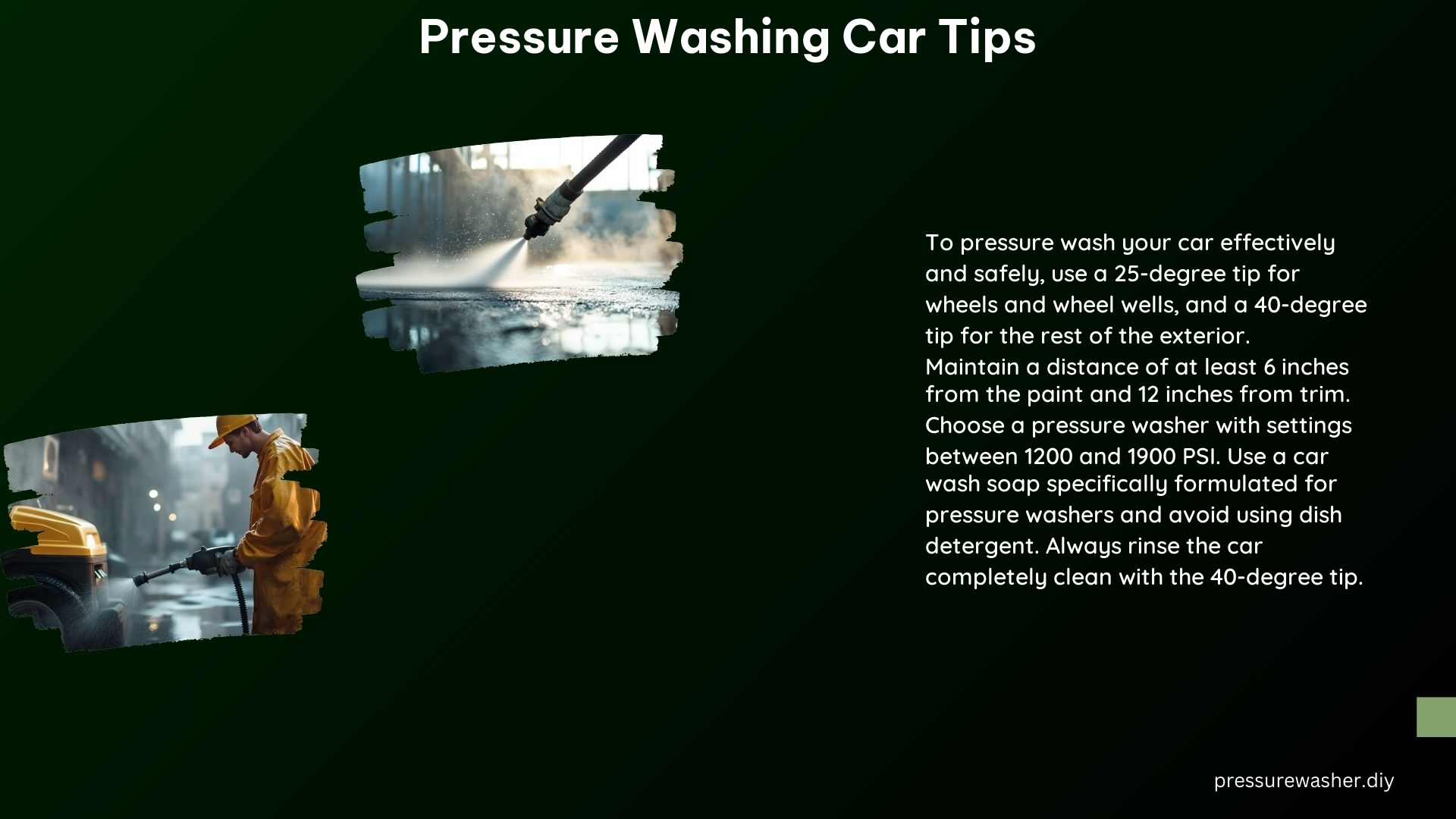Pressure washing a car can be an effective and efficient way to clean the vehicle, but it requires careful attention to detail to avoid damaging the paintwork and other surfaces. This comprehensive guide will provide you with the necessary tips and guidelines to pressure wash your car safely and effectively, ensuring a clean and spotless finish.
Choosing the Right Nozzle Tip
When it comes to pressure washing a car, the choice of nozzle tip is crucial. The right tip can make all the difference in achieving a thorough and gentle clean without causing any damage.
25-Degree Tip
- Use a 25-degree tip for cleaning wheels, wheel wells, and caked-on mud.
- This tip provides a more focused spray pattern, making it ideal for these heavily soiled areas.
- The concentrated stream of water can effectively remove stubborn dirt and grime without risking damage to the surrounding surfaces.
40-Degree Tip
- Use a 40-degree tip for cleaning the entire exterior of the car.
- This wider spray pattern is safer for the paintwork, as it reduces the risk of high-pressure water causing scratches or swirls.
- The 40-degree tip allows for a more even and gentle distribution of water, ensuring a thorough clean without compromising the integrity of the car’s finish.
Pressure Washer Settings

Selecting the appropriate pressure washer settings is crucial to ensure a safe and effective car wash.
PSI (Pounds per Square Inch)
- Choose a pressure washer with settings between 1200 and 1900 PSI.
- This range is suitable for most car washing tasks, providing enough power to remove dirt and grime without being overly aggressive.
- Pressure washers with lower PSI (around 1200-1500 PSI) are generally safer for use on cars, as they are less likely to cause damage to the paintwork.
Adjustable Pressure
- If your pressure washer has an adjustable unloader valve, set it to a lower pressure (around 1500 PSI) for washing the car.
- Higher pressures, even within the recommended range, can be too aggressive and may lead to damage to the car’s finish.
- Adjusting the pressure to a lower setting ensures a gentle and controlled cleaning process, minimizing the risk of scratches or other surface imperfections.
Safety Precautions
Pressure washing a car requires careful attention to safety to prevent any unwanted damage.
Distance
- Always keep the nozzle at least six inches away from the paint surface and 12 inches away from trim to avoid damage.
- Maintaining the proper distance ensures that the water pressure is not too concentrated on a specific area, which could lead to scratches or dents.
Avoid Damaged Paintwork
- Avoid using a pressure washer on areas with damaged paintwork, as it can worsen the existing damage.
- Instead, hand wash these areas with a microfiber wash mitt and a light concentration of car wash detergent.
- Gently cleaning the damaged areas by hand helps to preserve the integrity of the paint and prevent further deterioration.
No Direct Spray
- Do not spray directly into the front grille, as it can damage the radiator.
- Instead, spray downward at a 45-degree angle to avoid direct contact with the grille.
- This technique helps to protect the sensitive components behind the grille while still effectively cleaning the exterior.
Washing Techniques
Proper washing techniques are essential for achieving a thorough and safe clean when pressure washing a car.
Pre-Wash
- Start by pre-washing the car from the top down, removing debris and loose dirt.
- Use a 40-degree tip for this step, as it provides a wider spray pattern to effectively remove surface-level contaminants.
- This pre-wash step helps to loosen and lift dirt, making the subsequent washing and rinsing processes more effective.
Soap Application
- Apply soap using a soap tank or by hand with a rag or sponge.
- Let the soap sit for at least five minutes before rinsing to allow it to break down and emulsify the dirt and grime.
- The soap helps to lubricate the surface, reducing the risk of scratches and swirls during the washing process.
Rinse
- Rinse the car thoroughly with a 40-degree tip, starting from the top and working down.
- Repeat the rinse process two or three times to ensure all soap is removed, as any remaining soap can lead to water spots or streaks.
- A thorough rinsing is crucial to prevent any residual soap or dirt from drying on the surface and causing damage.
Additional Tips
To further enhance the effectiveness and safety of your pressure washing experience, consider the following additional tips.
Use a Foam Cannon
- If you have a foam cannon, use it to apply a lubricating car shampoo.
- The foam helps to create a protective layer between the pressure washer’s water and the car’s surface, reducing the risk of scratches and swirls.
- The lubricating properties of the shampoo also aid in the removal of dirt and grime, resulting in a more thorough and gentle clean.
Dry the Car
- Dry the car with a hand towel, soft cloth, or shammy to prevent water spots.
- Allowing the car to air dry can lead to the formation of water spots, which can be difficult to remove and may cause permanent damage to the paint.
- Carefully drying the car with a high-quality microfiber cloth or shammy helps to ensure a streak-free and spot-free finish.
By following these comprehensive guidelines and tips, you can safely and effectively pressure wash your car to achieve a clean and spotless finish, while minimizing the risk of damage to the vehicle’s paintwork and other surfaces.
References:
- https://www.turtlewax.com/blogs/how-to/how-to-clean-your-car-with-a-pressure-washer
- https://www.familyhandyman.com/project/how-to-pressure-wash-your-car/
- https://www.reddit.com/r/AutoDetailing/comments/bhh2x6/pressure_washing_car_which_spray_nozzle/
- https://www.youtube.com/watch?v=I29-3FK1EQE
- https://www.turtlewax.com/blogs/how-to/how-to-pressure-wash-a-car-the-right-way
